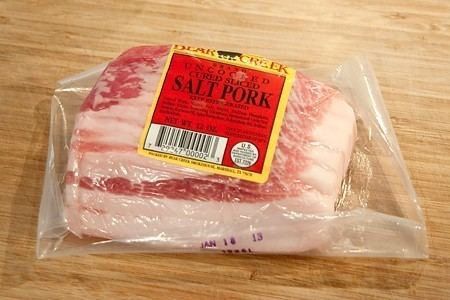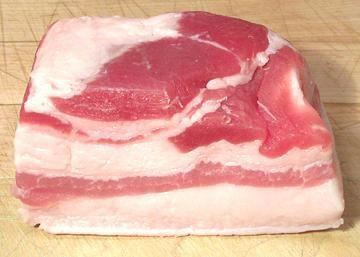 | ||
Similar Salt‑cured meat, Pork and beans, Hoppin' John, Salting, Pork jowl | ||
Preparing salt pork 18th century cooking series s1e5
Salt pork is salt-cured pork. It is prepared from one of three primal cuts: pork side, pork belly, or fatback. Depending on the cut, respectively, salt pork may be lean, streaky or entirely fatty. Made from the same cuts as bacon, salt pork resembles uncut slab bacon, but is considerably saltier and not bacon-cured or smoked. It is thus virtually identical to the Slavic food salo, which also displays similar variation in meat-to-fat ratio. Long used as a shipboard ration, salt pork now finds use in traditional American cuisine, particularly Boston baked beans, pork and beans, and to add its flavor to vegetables cooked in water, or with greens as in soul food. It is also central to the flavoring of clam chowder. It generally is cut and cooked (blanched or rendered) before use.
Contents
- Preparing salt pork 18th century cooking series s1e5
- Roast pork bellie aka salt pork fatback
- Streak of lean
- References
Along with hardtack, salt pork was a standard ration for many militaries and navies throughout the 17th, 18th, and 19th centuries, seeing usage in the American Civil War, War of 1812, and the Napoleonic Wars, among others.

Roast pork bellie aka salt pork fatback
Streak of lean
Streak of lean or "Streak o' lean" is the common name given to the much leaner version of salt pork or fatback. It is particularly popular in the Southeastern United States. It has a much higher meat content, as much as 50% by volume, and is typically salt-cured and sold in small blocks that can be cut and fried or used in other dishes. The streaking resembles regular bacon in many respects, including the marbling of meat and fat, although it is typically sold in blocks like regular salt pork with the skin intact. Like many cured pork products, it is typically very high in sodium due to the salt content.

As a stand-alone food product, it is typically boiled to remove much of the salt content and partially cook the product, then fried until it starts to develop a crisp exterior. It can be used as a stand-alone meat product or in many dishes that call for regular salt pork.
